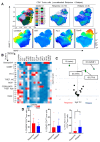Immunophenotyping of Peripheral Blood Cells in Patients with Chronic Lymphocytic Leukemia Treated with Ibrutinib
- PMID: 39273028
- PMCID: PMC11393851
- DOI: 10.3390/cells13171458
Immunophenotyping of Peripheral Blood Cells in Patients with Chronic Lymphocytic Leukemia Treated with Ibrutinib
Abstract
Chronic lymphocytic leukemia (CLL) is a B-cell-derived hematologic malignancy whose progression depends on active B-cell receptor (BCR) signaling. Despite the spectacular efficacy of Ibrutinib, an irreversible inhibitor of Bruton tyrosine kinase (BTK), resistance can develop in CLL patients, and alternative therapeutic strategies are therefore required. Cancer immunotherapy has revolutionized cancer care and may be an attractive approach in this context. We speculated that characterizing the immune responses of CLL patients may highlight putative immunotherapeutic targets. Here, we used high-dimensional spectral flow cytometry to compare the distribution and phenotype of non-B-cell immune populations in the circulating blood of CLL patients treated with Ibrutinib displaying a complete response or secondary progression. Although no drastic changes were observed in the composition of their immune subsets, the Ibrutinib-resistant group showed increased cycling of CD8+ T cells, leading to their overabundance at the expense of dendritic cells. In addition, the expression of 11 different surface checkpoints was similar regardless of response status. Together, this suggests that CLL relapse upon Ibrutinib treatment may not lead to major alterations in the peripheral immune response.
Keywords: chronic lymphocytic leukemia; immunotherapy; onco-immunology; spectral flow cytometry.
Conflict of interest statement
The authors declare no conflicts of interest related to this study.
Figures






References
Publication types
MeSH terms
Substances
Grants and funding
LinkOut - more resources
Full Text Sources
Research Materials

